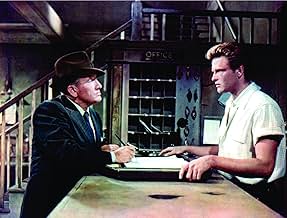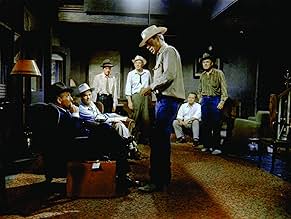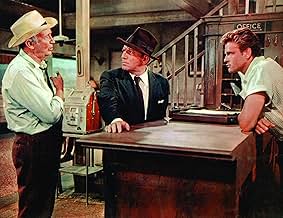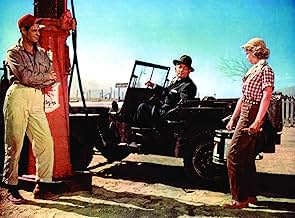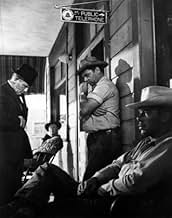Un inconnu manchot arrive dans une petite ville. Il veut garder son terrible passé secret, par des moyens violents si nécessaire.Un inconnu manchot arrive dans une petite ville. Il veut garder son terrible passé secret, par des moyens violents si nécessaire.Un inconnu manchot arrive dans une petite ville. Il veut garder son terrible passé secret, par des moyens violents si nécessaire.
- Director
- Writers
- Stars
- Nommé pour 3 oscars
- 4 victoires et 8 nominations au total
- Cafe Lounger
- (unconfirmed)
- Cafe Lounger
- (unconfirmed)
- Cafe Lounger
- (unconfirmed)
- Cafe Lounger
- (unconfirmed)
- Second Train Conductor
- (uncredited)
- First Train Conductor
- (uncredited)
- One of Two Porters
- (uncredited)
- Tall - White-haired Cafe Lounger
- (uncredited)
Avis en vedette
A classy production that combines elements of Westerns and film noir, Bad Day at Black Rock deals with racism and all the hate and bully tactics that come with such a vile subject. It tells the story of a mysterious one armed stranger, John J. Macreedy (Tracy), who arrives at a tiny isolated town in a desert of the Southwest United States in search of a Japanese-American man. From the moment he arrives he is met with hostility and mistrust. Over the course of the day Macreedy picks apart the town to uncover the secret that the towns folk had hoped had gone away forever.
From the opening sequence of a bright red train rushing towards us, it's evident that we are in the modern day West. It's just after World War II and the horse trails of the old West are now frequented by jeeps and cars. Yet the hallmarks of the old West exists and thrives because of the inhabitants of Black Rock. An ignorant group of people consisting of bullies, drunks and the head in the sand weak willed type. Yet even though the film is set mostly in the blazing sun, in a barren one horse Western town that time forgot, the film exudes a film noir sensibility. Dark secrets from the past weigh heavy on the shoulders of the towns' big players - and Tracy's High Noon like situation is moodily paced by the wily Sturges. In fact, that a film with so little "gun play" action can be so tense is actually no mean feat, with him yet again directing an ensemble cast to great effect.
Tracy is at his best when he is as he is here, playing subdued. Here he is a thinking man's protagonist, calm and reflective in the face of constant hostility. That he is facing an impressive line up of heavies really brings home just how thoughtful a performance Tracy gives in the piece. Robert Ryan does yet another fine turn as a complicated villain whose rage is bubbling away under the surface. Borgnine and Marvin are memorably vile as his right hand thugs, Dean Jagger as the drunken cowardly sheriff manages to pang the heart and Walter Brennan is his usual solid scene influencing self. Anne Francis adds the glamour but really - and sadly - it's a nondescript role that the film could easily have survived without.
Clocking in at just 81 minutes the film never outstays its welcome. It looks great on home format issue, and for those interested in commentary tracks, this one comes with a very good one from Dana Polan. Anyone who has not seen this film should try and seek it out. It was considered controversial back on release but now can be viewed as a smart message movie about racial tolerance. Tight, taut and expertly directed and acted, Bad Day At Black Rock is an important film from the 50s that still rings the bells loudly even today. 8/10
Most people will tell you this film is famous because it was one of the first times an American film acknowledged that, after Pearl Harbour, oriental Americans were abused and treated badly. However to me this film is a damnation to those who stand back and refuse to take a stand against wrong doing. The whole plot is hinged on whether or not people ill stand up and do the right thing with Macreedy. The film plays well as a moral fable but also as a tense thriller and both are enjoyable.
The film is quite short, but builds well from hostile locals to eventual violence and confrontation in the desert. The moral of taking a stand is weaved into it well without taking away from the main drama and tension. It isn't perfect as it is a bit simplified but in the desert heat of the small town the tension is really well recreated.
The cast is surprisingly deep in hindsight. Tracy is manners himself as the man who gets more irate by the apathy around him as he gets to uncover more and more of the town. Ryan is cool but a little too inhuman for my tastes. Jagger and Brennan are suitably trapped in their performances and represent those happy to watch bad things happen if they get a quiet life. In retrospect Borgnine and Marvin add star power and do well with what could have been just thug/heavy roles.
Overall this film worked for me on several levels. The heat of the desert adds to the tension in the actual drama story itself. However it also works as a moral fable with a very clear message stand up for what is right or watch what you believe slip away at an alarming rate.
I read a review of the film on IMDB pointing out the flaws in the script. They are all correct, if we go by rational thinking. But the merits of this film are the superb editing, the beautiful cinemascope photography and the arresting performances. Every time I see this film I am reminded of Spielberg's little known film "Duel" that had similar thrilling tension packed into less than 24 hours of screen time--a film I admire much more as good cinema than the recent box office outputs of Spielberg.
Compare this film with Sturges' "The Magnificent Seven." Sturges like King Vidor, seemed to pick up stories to film that looked at the oppressed and tried to present a world that could be better. "The Magnificent Seven," like this film, had a predominantly male cast. It appealed to most viewers. And some could see a social and even a political layer beneath these films.
What I find most appealing is the the ability of Sturges, Vidor, and the early unsung Spielberg's ability to use cinema to combine thrills, human values and craft in say 81 minutes as in this film. Spencer Tracy is not to be admired for the way he delivers his lines, but his body movements which remind you of majestic caged animal that can be deadly if provoked. Sturges brings to the fore evil in different ways--the dead buck strapped on the front of a vehicle, menace on empty roads by big vehicles (used in "Duel" to great effect), evil women when you expect them to be good, laws used in illegal ways (the hotel registration scene), etc. Sergio Leone made similar films in Europe--the famous spaghetti westerns--with laconic dialogues and emphasis on body movements and photography
In spite of its flaws, it is a film Hollywood can be proud of. I only hope TV reruns show the film in its original cinemascope grandeur, which grabbed me the first time I saw it decades ago.
Tracy gets off a train at a hole in the wall, whistlestop, speedtrap of a town called Black Rock located somewhere in the Mojave desert. He's looking for a Japanese farmer named Komoko who seems to have vanished. And the townspeople are downright unfriendly to the stranger.
It gradually dawns on Tracy that by probing about Komoko's whereabouts, he's stepped in one big festering pile and he's put himself in danger. What he does about it is the rest of the film.
John Sturges keeps the tension going here worthy of an Alfred Hitchcock film. In fact if Hitchcock had ever decided to do a western and was presented with Bad Day at Black Rock, I doubt he could do it any better. Certain arty Hitchcock touches are missing, but the suspense is there. Sturges was in fact nominated for Best Director.
As was Tracy nominated for Best Actor. He lost ironically to one of his fellow cast members Ernest Borgnine who copped the big prize for Marty. But in fact any one of the small cast could have been nominated. I'm not sure why chief villain Robert Ryan wasn't.
A fews years later John Sturges directed another film The Law and Jake Wade about Robert Taylor being held prisoner by Richard Widmark and his gang. There was a lot of suspense there as well, similar to Bad Day at Black Rock, as to whether Taylor would escape his predicament.
For a feature film in 1955 it is a rather short one, less than 90 minutes. But as Tracy said in another film, what there is is cherce.
Le saviez-vous
- AnecdotesJohn Sturges had already moved on to his next film, The Scarlet Coat (1955), so Herman Hoffman took charge of filming the opening. The plan was to shoot the train hurtling toward the audience, almost like a 3-D movie, but it would have been deadly to attempt a helicopter maneuver into the path of a speeding locomotive. Stunt flier Paul Mantz offered the perfect solution: have the train running backwards, fly the copter over the retreating engine, then project the footage in reverse. "It's a helluva shot," Sturges later said, "but I didn't make it."
- GaffesAs the train approaches the town, the horn blows twice, which is the signal for starting up. The mandatory signal for a grade crossing (long, long, short, long) is never blown, although one clearly exists. When the train departs, the conductor makes a confused hand signal to the engineer resembling the horizontal motion that means "stop" rather than the vertical motion that means "go". The engineer never responds with the "long, long" starting signal.
- Citations
Reno Smith: I swear, you're beginning to make me mad.
John J. Macreedy: All strangers do, hmm?
Reno Smith: No, they don't. Not all of them. Some do, when they come around snooping...
John J. Macreedy: Snooping for what?
Reno Smith: I don't know, outsiders coming in, looking for something...
John J. Macreedy: Looking for what?
Reno Smith: I don't know! Somebody's always looking for something in this part of the West. To the historian it's the Old West, to the book writer it's the Wild West, to the businessman it's the Undeveloped West -- they say we're all poor and backward, and I guess we are, we don't even have enough water. But to us, this place is *our* West, and I wish they'd leave us alone!
John J. Macreedy: Leave you alone to do what?
Reno Smith: I don't know what you mean.
- Autres versionsTo receive an 'A' (PG) certificate in 1955 the UK cinema version was subject to heavy BBFC cuts. These included Macreedy striking Hector with the brass fire hose nozzle and the climactic shots of Reno on fire. Later TV showings and video releases were fully uncut.
- ConnexionsFeatured in The Spencer Tracy Legacy: A Tribute by Katharine Hepburn (1986)
Meilleurs choix
Détails
Box-office
- Budget
- 1 271 000 $ US (estimation)
- Brut – à l'échelle mondiale
- 10 813 $ US
- Durée
- 1h 21m(81 min)
- Couleur
- Rapport de forme
- 2.35 : 1


